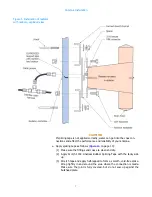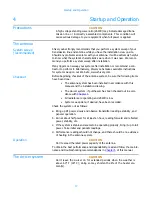
Maintenance and Troubleshooting
20
Return policy
When returning any material to the factory, be sure to call your salesman and
obtain an returned material authorization (RMA) number first. Use this num-
ber in all correspondence. This number helps us to track your returned item. It
will expedite repair or replacement and prevent loss of your material.
Troubleshooting
Cantact Shively Labs if necessary to help find the cause of your problem. Out-
side of 8:00 AM to 5:00 PM Eastern Time, call (207) 329-5118.
Internal arcing
Internal arcing is caused by physical damage to transmission line, feedline, or
radiators. Damage may have been caused by ice, lightning, tower work, or
many other factors. Replace damaged components.
Broad spectrum RF noise
Any metal part in poor contact with the tower will constitute a non-linear junc-
tion and cast a broad-spectrum signal. This includes antennas, transmission
line, mounts, ladders, and other electrical components. Check your antenna
mounts and other tower components to be sure that the tower paint was
scraped away during installation and that all mounting hardware is tight.
High VSWR at startup or
during operation
High VSWR (Voltage Standing Wave Ratio) is caused by any factor which
changes the impedance match between the transmitter and the antenna sys-
tem. Possible causes include:
• Wrong antenna for the application and frequency. Occasionally
incorrect frequency information is provided to Shively or an antenna
designed for another application is used.
• Defective cable connector in the cable harness.
• Incorrect assembly of the antenna (for example, an upside-down
radiator; radiators out of sequence). The assembly must be exactly
as shown in the installation drawing.
• Damaged radiator feed strap(s). The feed strap is the metal strip
that extends back from the end seal. The length, angle, and
straightness of the feed strap are critical to the radiator's perfor-
mance.
• Components of other services in the RF field (later installations or
broken components).
• Physical damage to the transmission line, feedline, or radiators.
This may be from ice, lightning, tower work, or any other source.
(Check with the tower owner to see whether anyone has been
working on the tower.)
• Paint applied to the radiators, for example during a recent tower
painting.
• De-icer failure may have allowed ice buildup or melted the solder
from the domes, spacers, and bushings at the ends of the vertical
arms.
Change in coverage
Changes in broadcast coverage may be caused by the same factors that pro-
duce VSWR changes. If coverage seems to have changed, look for VSWR
changes and use
High VSWR at startup or during operation
troubleshooting.



































